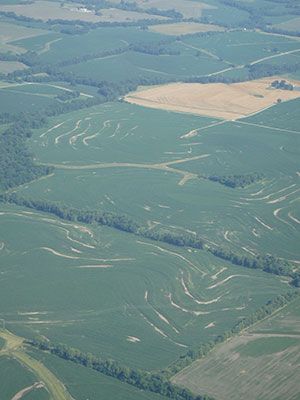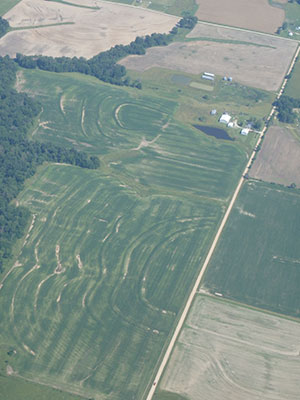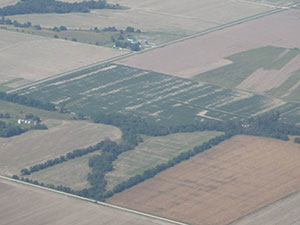Taking an environmentally sensitive approach to pest management
Aerial tour shows that a minority of north Missouri corn fields have nitrogen deficiency
Published: July 11, 2013
Most of Missouri received over 16 inches of rain from April to June. My rule of thumb is that well-drained soils will lose a substantial amount of preplant N when this occurs.

Many north Missouri cornfields look pretty darn good considering what they’ve been through.
And most of northeast Missouri, with dominantly poorly-drained soils, received over 12 inches of rain in May and June. The same is true for large areas of southwest Missouri. My rule of thumb is that these poorly-drained soils will lose a substantial amount of preplant N when this occurs.
But the proof is in how the corn looks, and a lot of the corn in northern Missouri looked green when I did an aerial tour on July 4. The tour started in Columbia, traveled up the Missouri River to Glasgow, cut across to Marshall, then up to Salisbury, Moberly, Macon, Monroe City, and Hannibal, then turned and returned to Columbia via Vandalia and Mexico. Thank you Bob Boyes for taking me on this tour.
Along this route, I would say that only 20% of corn fields had visible N deficiency, and probably only half of these fields would be economical to treat with an additional N application. This is far lower than the proportions seen in the wet springs of 2008, 2009, and 2010. The highest proportion of N-deficient fields were in the river bottom, but the upland claypan soils had quite a few too. Deep loess soils in the Marshall area showed very little N deficiency (photo at left).

Although many fields look good, there are also plenty like this one with N deficiency. This can be corrected by applying more N until a week or two after tassel.
One reason for less N deficiency than 2008-2010 is that a lot of fields have received N since planting. Some of these applications were planned, others in response to the wet weather. Talking with around a dozen sources (including Iowa and Illinois), my impression is that somewhere near half of all corn fields have had some N applied since planting. These in-season N applications provide very effective delivery to the crop even in a wet year, and I expect that all of these fields are among those that are nice and green.
Rainfall intensity is another likely reason. More of the rain came in big chunks this year,meaning that more of it ran off. This is more likely to cause soil loss than N loss. Two people (in two states) have told me that erosion in their area is the worst they have ever seen it.
Rain that ran off is not in the field, and therefore not saturating the soil and stimulating denitrification. In Columbia, May-June rainfall in events less than 2.5 inches was about 7 inches this year (of almost 12 inches total), compared to 9.5 to 12.5 inches in 2008- 2010. Total May-June rainfall was within an inch of the same for these four years, but much more of it came in intense storms in 2013.
A cool first week of May may also have contributed, since denitrification is temperaturesensitive.
Whatever the reason, it looks to me like the number of producers losing yield and money due to N deficiency is going to be much lower in 2013 than it was in 2008-2010.

I saw lots of stand problems. These will probably cost Missouri corn producers as much as N problems in 2013.
For those who have fields with deficiencies, there is still plenty of time for the corn to respond to additional N if you can find a way to get it applied. Broadcasting urea (highboy or airplane), dropping N solution between the rows, or injecting N in irrigation water are the best application methods at this stage. Drop nozzles for N need to be long enough to get the N below the ear leaf if the corn is far enough along to have one.
Subscribe to receive similar articles sent directly to your inbox!
REVISED: October 1, 2015